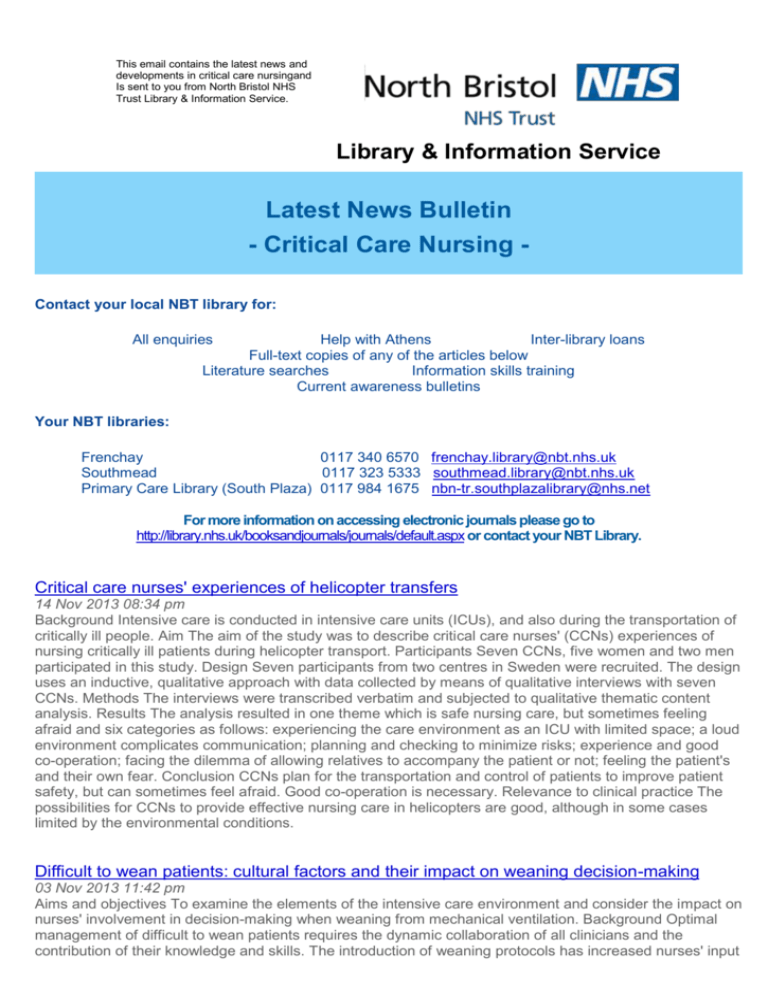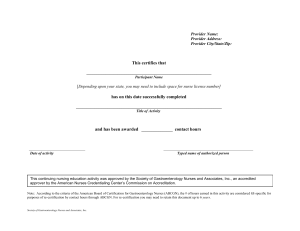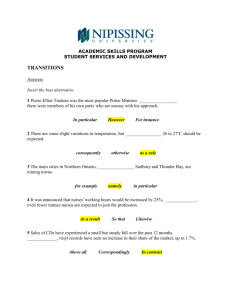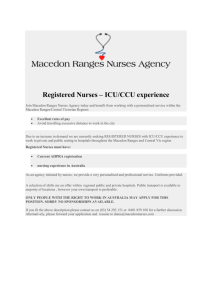
This email contains the latest news and
developments in critical care nursingand
Is sent to you from North Bristol NHS
Trust Library & Information Service.
Library & Information Service
Latest News Bulletin
- Critical Care Nursing Contact your local NBT library for:
All enquiries
Help with Athens
Inter-library loans
Full-text copies of any of the articles below
Literature searches
Information skills training
Current awareness bulletins
Your NBT libraries:
Frenchay
0117 340 6570 frenchay.library@nbt.nhs.uk
Southmead
0117 323 5333 southmead.library@nbt.nhs.uk
Primary Care Library (South Plaza) 0117 984 1675 nbn-tr.southplazalibrary@nhs.net
For more information on accessing electronic journals please go to
http://library.nhs.uk/booksandjournals/journals/default.aspx or contact your NBT Library.
Critical care nurses' experiences of helicopter transfers
14 Nov 2013 08:34 pm
Background Intensive care is conducted in intensive care units (ICUs), and also during the transportation of
critically ill people. Aim The aim of the study was to describe critical care nurses' (CCNs) experiences of
nursing critically ill patients during helicopter transport. Participants Seven CCNs, five women and two men
participated in this study. Design Seven participants from two centres in Sweden were recruited. The design
uses an inductive, qualitative approach with data collected by means of qualitative interviews with seven
CCNs. Methods The interviews were transcribed verbatim and subjected to qualitative thematic content
analysis. Results The analysis resulted in one theme which is safe nursing care, but sometimes feeling
afraid and six categories as follows: experiencing the care environment as an ICU with limited space; a loud
environment complicates communication; planning and checking to minimize risks; experience and good
co-operation; facing the dilemma of allowing relatives to accompany the patient or not; feeling the patient's
and their own fear. Conclusion CCNs plan for the transportation and control of patients to improve patient
safety, but can sometimes feel afraid. Good co-operation is necessary. Relevance to clinical practice The
possibilities for CCNs to provide effective nursing care in helicopters are good, although in some cases
limited by the environmental conditions.
Difficult to wean patients: cultural factors and their impact on weaning decision-making
03 Nov 2013 11:42 pm
Aims and objectives To examine the elements of the intensive care environment and consider the impact on
nurses' involvement in decision-making when weaning from mechanical ventilation. Background Optimal
management of difficult to wean patients requires the dynamic collaboration of all clinicians and the
contribution of their knowledge and skills. The introduction of weaning protocols has increased nurses' input
in decision-making, but there are various elements of the decision environment that impact on their
involvement, which have been given little consideration. Design Ethnography was used as the research
design for this study. Methods Fieldwork took place in two tertiary hospitals in Greece and Scotland for five
months each to unveil clinicians' behaviour and interactions during the weaning practice. Observation was
based on the weaning process of 10 Scottish and 9 Greek long-term ventilated patients. Semi-structured
interviews followed with nurses (n = 33) and doctors (n = 9) in both settings to understand nurses' perceived
involvement in weaning decision-making. Thematic analysis of interviews and field notes followed using the
Qualitative Data Analysis software NVivo. Clinicians' participation was voluntary. Results The main themes
identified were the (1) organisation of the units (time and structure of the ward rounds, staff levels and staff
allocation system), (2) the inter- professional relationships, (3) the ownership and accountability in weaning
decision-making and (4) the role of the weaning protocols. These elements described the culture of the
ICUs and defined nurses' role in weaning decision-making. Conclusions Clinical decision-making is a multidynamic process specifically in complex clinical situations such as weaning from mechanical ventilation.
This paper suggests that weaning practice should be considered in relation to the elements of the clinical
environment to provide an individualised and patient-centred weaning approach. Relevance to clinical
practice Methods to enhance nurses' role in teamwork and collaborative decision-making are suggested.
Enhancing person-centred communication in NICU: a comparative thematic analysis
14 Nov 2013 08:34 pm
Aims and objectives Aims of this article were (a) to explore how parents of premature infants experience
guided family-centred care (GFCC), and (b) to compare how parents receiving GFCC versus standard care
(SC) describe nurse-parent communication in the neonatal intensive care unit. Background Family-centred
care (FCC) is acknowledged as fundamental to supporting parents of premature infants, and
communication is central to this practice. Accordingly, nurses need good communication skills. GFCC is an
intervention developed to improve nurse-parent communication in the neonatal intensive care unit. This
intervention helps nurses to realize person-centred communication as an approach to optimize
contemporary practice. Design Our qualitative study had a descriptive and comparative design using semistructured interviews to explore the parent's experience of GFCC. Methods We conducted 10 dyad
interviews with parents (n = 20) and two individual interviews with mothers of premature infants (n = 2).
Parents in the intervention group versus SC group were 13 versus 9. Thematic analysis was applied.
Findings GFCC was generally experienced as supportive. Three interrelated themes were identified that
illustrated how the intervention helped parents cope as persons, parents and couples: (a) discovering and
expressing emotions, (b) reaching a deeper level of communication, and (c) obtaining mutual
understanding. In contrast, SC communication was more superficial and less structured. Factors such as
inaccessibility of nurses, inability to ask for assistance and parent popularity impaired successful
communication. Conclusion and implications for practice Our study suggested that compared to SC, GFCC
provided structured delivery of supportive communication between nurses and parents of premature infants.
The intervention promoted the discovery of the parents' individual preferences and concerns, which enabled
more focused communication, and set the stage for better nurse-parent and parent-parent understanding.
We recommend GFCC as a method to improve communication in the neonatal intensive care unit.
Jordanian nurses' knowledge and responsibility for enteral nutrition in the critically ill
26 Nov 2013 08:32 pm
Objectives This study aimed to assess nurses' practice and perception of their knowledge and responsibility
in relation to enteral nutrition (EN) in the critically ill. Background Poor nursing adherence to evidencebased guidelines has negative consequences leading to higher mortality rates, delayed recovery and longer
length of stay. Evidence-based practice has the potential to minimize complications and discrepancies
between nurses. Design and methods This descriptive correlational design was applied to nurses working in
intensive care units (ICUs) from three health care sectors in Jordan (Governmental, Military and Private
sectors). Nurses were recruited using a stratified sampling technique. A pre-prepared questionnaire
focusing on nurses' practice and perception towards EN was used. Results A total of 253 ICU nurses
completed the questionnaire. Nurses revealed a tendency to undertake nutritional care despite the
recognition clinical nutrition is a secondary role. In terms of nursing processes, nurses showed greater
levels of knowledge and responsibility for ‘preventing complications’ and ‘evaluation’ more than
‘assessment’ and ‘identifying goals’. Nurses inadequately assess both gastric residuals and tube placement
before feeding. Diarrhoea was the most frequent complication followed by abdominal pain, vomiting, tube
dislodgment and weight loss. However, nurses realized that the incidences of complications is less likely
when applying evidence-based protocol. Conclusion It is necessary to establish a preliminary assessment
for patients' nutritional needs prior to using EN. Aspiration reduction measures are still deficient and need
further attention. An evidence-based protocol for EN should be adopted in the critically ill. Relevance to
clinical practice This article provides insight into the current practice of Jordanian intensive care nurses in
different health care sectors. The study can contribute to redirect the perception of nurses towards nutrition
in the critically ill in addition to enhance positive adherence to evidence base.
Paediatric intensive care nurses' and doctors' perceptions on nurse-led protocol-directed
ventilation weaning and extubation
26 Nov 2013 08:32 pm
Background Nurse-led (protocol-directed) ventilation weaning (NLVW) is utilized in adult intensive care and
has shown to be safe and reduce ventilation times. Our paediatric intensive care unit (PICU) implemented a
NLVW (and extubation) protocol in 2004, yet it was observed that some NLVW-trained nurses were not
undertaking the role in practice. Aims To explore PICU nurses' and doctors' perceptions of and barriers to
NLVW on a UK PICU, with the aim of facilitating more NLVW on our PICU by reducing these barriers.
Methods A cross-sectional electronic survey was used to collect data from both nurse ventilation weaners
and all medical staff and advanced nurse practitioners (ANPs) on one PICU. Results Our survey response
rates were 90% (36/40) nursing and 54% (20/37) medical. The four top reasons cited for nurses not being
able to wean by protocol were not being allocated to a ‘weanable’ patient, being in an in-charge or runner
role, high clinical workload and a perceived lack of support from medical staff/ANPs. The restrictive nature
of our protocol also emerged as a key issue by all staff. The medical survey revealed an overwhelming
positive response to NLVW with 90% believing that experienced PICU nurses should be allowed to wean
ventilation. In contrast to the nurses perceived lack of support or encouragement for NLVW, medical staff
rated their encouragement for the nurses to undertake this role as high. Conclusions NLVW is a complex
process, and factors that impair or facilitate this process relate not only to the weaning protocol itself, but
also organizational processes and structural factors in a PICU. Relevance to clinical practice This paper
highlights the complexities involved in instituting and establishing a nurse-led, protocol-driven ventilation
weaning process within a PICU. Further, in depth research is required to examine both PICU nurses and
doctors attitudes to NLVW both in the UK and across Europe.
Patient safety: Committing to learn and acting to improve - Corrected Proof
25 Nov 2013 12:00 am
Providing high quality safe healthcare is a global challenge for healthcare systems and organisations ().
Ensuring patient safety is a fundamental principle of healthcare organisations, managers and practitioners'
professional responsibility. However, patients continue to experience unsafe care in increasingly complex,
high pressure healthcare settings (). and note the lack of significant progress in improving patient safety
over the previous decade. Nurses as the largest component of the health workforce play a critical role in
providing safe patient care. They provide 24hour, seven day a week direct care to patients, examining
clinical changes and activating rescue activities. In addition nurses also undertake coordination and
integration of care services from multiple health care staff. As such they are essential to safe, high quality
care and yet are often invisible to the public in this role until things ‘go wrong’. The most recent example of
this is the which found evidence that the Mid Staffordshire NHS Trust in the United Kingdom had an
unacceptable standard of care which was prevalent throughout the hospital. Much of the care was delivered
by healthcare support workers who were providing the most intimate and critical care to patients at their
time of greatest need. Yet these patients were not afforded adequate protection from those who were ill
equipped to perform the care role which contributed to high patient mortality (). The patient care quality and
safety issues highlighted in the are deeply disturbing; important lessons can be learnt by all healthcare
systems. One such lesson is the importance of the nurse's role in patient surveillance and rescue of
patients from harm which cannot be realised without sufficient nurses to provide appropriate care. There is
no doubt the Mid Staffordshire NHS Trust enquiry shocked the nation and brought high levels of
engagement from the Government and the National Health Service.
Plasma exchange in the intensive care unit: A 10 year retrospective audit - Corrected Proof
19 Nov 2013 12:00 am
Abstract: Background and aims: Plasma exchange (PE) is a therapeutic technique for the removal of
illness-associated antibodies and toxins. Little is currently known about the prescription and technique for
PE in the Intensive Care setting. In addition, different illnesses require specific PE regimens to optimise the
clinical outcome for the patient. We sought to audit our use of PE for: number of treatments, clinical
indications, treatments prescribed and administered, any procedural or patient complications, and
adherence to current best practice recommendations.Method: A retrospective audit involving all patients
who were admitted to our tertiary 20 bed Intensive Care Unit (ICU) and received PE therapy between 1
January 2002 and 31 December 2011. Data was collected from identified patient medical records using a
specifically designed case report form.Results: Thirty unique patients were identified in this audit. There
was an incidence of 0.15% use of PE during this period. Eighteen female patients (60%) were indentified,
median age 59.5 (48–70) years. These 30 patients were prescribed 135 PE treatments, requiring 156
membranes in total with a 15.5% incidence of premature circuit clotting. Thrombotic Thrombocytopenic
Purpura (TTP) was the most common indication for PE (37%) with 10 other clinical indications. Median
length of ICU admission was 9.5 (3–17) days. The PE regimens received by patients in this ICU were not
always prescribed in accordance with current best practice recommendations. No patient complications
were identified with these PE treatments.Conclusion: PE is a valuable treatment option for critically ill
patients suffering antibody-mediated illness. The findings of this audit have identified differences between
the current prescription recommendations for PE and those applied. TTP was the most common indication
for PE, and no patient complications were identified, however a 15.5% incidence of circuit clotting occurred.
The infrequency of the therapy and the different indications present a challenge for Intensive Care clinicians
to provide best care in all cases. Improving the prescription of PE through the implementation of a new
protocol and clinical education may result in better outcomes for our patients.
The effect of individualised developmental care practices on the growth and hospitalisation
duration of prematures: mother's scent and flexion position
20 Nov 2013 02:30 am
Aim and objective To assess the effect of individualised developmental care practices on the growth and
hospitalisation duration of prematures. Background It is known that individualised developmental care
practices enable premature infants to have rapid weight gain, intensive care complications to decrease, to
have earlier discharge from the hospital and the related cost to reduce. Design The study used an
experimental design. Methods The study was carried out with prematures who received treatment and care
in the newborn intensive care unit (n = 97). Infants were randomised into three groups: mother's scent,
flexion and control. Infants were monitored every care hours of each day until the discharge and the
measurements were recorded. The data obtained were analysed by t-test, percentage distributions, means,
chi-square test, analysis of variance and Bonferroni test. Results It was determined in the study that there
was a significant difference between experimental and control groups in terms of means of their discharge
weight and height, and this difference was associated with the mother-scent group (p < 0·05). While the
within-group difference between hospitalisation and discharge weight means was significant only in the
mother-scent group (p < 0·05), the within-group difference between hospitalisation and discharge height
means was significant in all three groups (p < 0·05). Even though the within-group difference between
means of hospitalisation duration of premature infants was insignificant (p > 0·05), means in the
experimental groups were determined to be lower than the means in the control group. Conclusion As the
methods of mother's smell and flexion position interventions support premature infants' growth and shorten
their hospitalisation duration, it is important to use routinely them at newborn intensive care unit. Relevance
to clinical practice Newborn intensive care unit nurses might lay the premature infants down in the flexion
position and make them sense their mother's scent to accelerate their growth and shorten their
hospitalisation duration.
Talk to us about our bulletins!
We'd love to hear what you think of this bulletin. Is it too vague? Too specific? Spot on? Is it doing the job or
missing the mark?
Is there a resource we've missed out? Do you need a bulletin on a different topic?
Please let us know (contact details above) so that we can provide you with a better service! We currently
have bulletins on the following topics, available weekly or monthly, by email or post:
A&E
Haematology
Patient Safety & Clinical Risk
Anaesthesia
Health Psychology
Physiotherapy
Brain Injury
Heart Failure
Plastic & Reconstructive Surgery
Breast Care
Management & Quality
Primary Care
CAMHS
Medical Education
Psychodynamics
Cardiology
Mental Health Commissioning
Public Health
Care of the elderly
Mental Health Nursing
Renal Care
Continence
Neurosurgery
Renal Nursing
Critical Care Nursing
Obstetrics & Gynaecology
Safeguarding Children
Dementia
Oncology
Sexual Health
Diabetes
Ophthalmology
Substance Misuse
Dietetics
Paediatric Burns
Vascular Surgery
End-of-life Care
Paediatrics
Wound Care
ENT
Copyright © 2013 North Bristol NHS Trust Library & Information Service, All rights reserved.
You are receiving this email because you opted in via the library service at Frenchay, Southmead or South
Plaza.
Our mailing address is:
North Bristol NHS Trust Library & Information Service
1st Floor, Learning & Research, Southmead Hospital
Westbury-on-Trym
Bristol, Eng BS10 5NB
United Kingdom
Add us to your address book
unsubscribe from this list update subscription preferences






